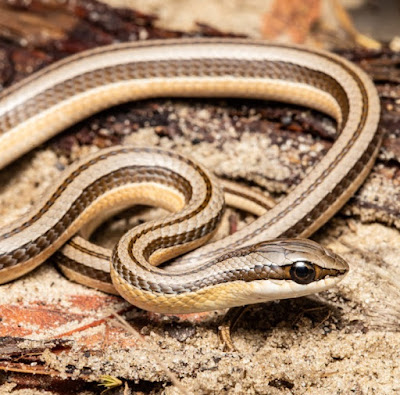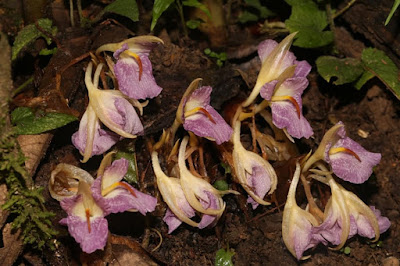 |
| Epinecrophylla spp. in Johnson, Howard & Brumfield, 2021. |
new & recent described Flora & Fauna species from all over the World esp. Asia, Oriental, Indomalayan & Malesiana region
Thursday, December 31, 2020
[Ornithology • 2021] Genus Epinecrophylla • Systematics of A Neotropical Clade of Dead-leaf-foraging Antwrens (Aves: Thamnophilidae)
[Ichthyology • 2020] Microcambeva bendego • A New Catfish Species of Microcambeva Costa & Bockmann 1994 (Siluriformes: Trichomycteridae) from A Coastal Basin in Rio de Janeiro State, southeastern Brazil
 |
| Figure 2. Ventral view of holotype of Microcambeva bendego, new species, holotype, MNRJ 52042, 28.1 mm SL, white arrow indicates the finger-like projections. Scale bar: 1.0mm. |
[Botany • 2020] Primulina elegans (Gesneriaceae) • A New Species from North Vietnam
 |
| Primulina elegans B. M. Wang, Y. H. Tong & N. H. Xia in Tong, Wang, et al., 2020. |
[Herpetology • 2020] Leptotyphlops sylvicolus Broadley & Wallach, 1997 • One Species hides Many: Molecular and Morphological Evidence for Cryptic Speciation in A Thread Snake (Serpentes: Leptotyphlopidae)
 |
| Leptotyphlops sylvicolus Broadley & Wallach, 1997 in Busschau, Conradie & Daniels. 2020. DOI: 10.1111/jzs.12401 |
Abstract
We investigate the phylogeographic structure of a fossorial forest‐living snake species, the forest thread snake, Leptotyphlops sylvicolus Broadley & Wallach, 1997 by sampling specimens from the Eastern Cape and KwaZulu‐Natal provinces of South Africa. Phylogenetic results, using Bayesian inferences and maximum likelihood, from the combined mitochondrial sequence data (cyt b and ND4), along with population genetic analyses suggest the presence of phylogeographic breaks broadly congruent to those exhibited by other forest‐living taxa. Divergence‐time estimates indicate that cladogenesis within the study taxon occurred during the late Miocene climatic shifts, suggesting that cladogenesis was driven by habitat fragmentation. We further investigate the species‐level divergence within L. sylvicolus by including two partial nuclear loci (PRLR and RAG1). The three species delimitation methods (ABGD, bGMYC, and STACEY), retrieved 10–12 putative species nested within the L. sylvicolus species complex. These results were corroborated by iBPP implementing molecular and morphological data in an integrative Bayesian framework. The morphological analyses exhibit large overlap among putative species but indicate differences between grassland and forest species. Due to the narrow distributions of these putative species, the results of the present study have further implications for the conservation status of the L. sylvicolus species complex and suggest that forest and grassland habitats along the east coast of South Africa may harbor significantly higher levels of diversity than currently recognized.
[Botany • 2020] Zingiber porphyrochilum (Zingiberaceae) • A New Species from Yunnan, China
[Herpetology • 2019] Kladirostratus gen. nov. & Psammophylax kellyi • A Snake in the Grass: Genetic Structuring of the Widespread African Grass Snake (Psammophylax Fitzinger 1843), with the Description of A New Genus and A New Species
 |
| Kladirostratus acutus (Günther 1888) in Keates, Conradie, Greenbaum & Edwards, 2019. DOI: 10.1111/jzs.12337 |
 |
| Kladirostratus acutus comb. nov. |
[Entomology • 2020] Description of the Male of Tanyxiphium harriet (Hymenoptera: Mymaridae), with New Distribution Records and Synonymy
 |
| Tanyxiphium harriet Zeya 2015 in Triapitsyn, Aishan & Huber, 2020. |
[Crustacea • 2020] New Records of Two Sponge-associated Species of Upogebia Leach, 1814 (Decapoda: Gebiidea: Upogebiidae) from southern India: U. hexaceras and U. nithyanandan resurrected from the synonymy of U. balmaorum
 |
Upogebia nithyanandan (Sakai, Türkay & Al Aidaroos, 2015) |
 |
| Upogebia nithyanandan (Sakai, Türkay & Al Aidaroos, 2015). Living specimen (male cl 4.3 mm; DABFUK/ AR-AN 111) inhabiting burrow in an unidentified sponge. |
[Fungi • 2020] Amended Description of the rarely reported Bryophilous Ascomycete Octospora svrcekii (Pyronemataceae) with Notes on the Phylogeny of the Section Wrightoideae
 |
| Octospora svrcekii Benkert (1998) in Sochorová, Matočec, Kušan, et al., 2020. |
Wednesday, December 30, 2020
[Paleontology • 2021] An Oviraptorid Preserved Atop An Embryo-bearing Egg Clutch sheds light on the Reproductive Biology of Non-avialan Theropod Dinosaurs
 |
| an oviraptorid specimen [LDNHMF2008] consisting of an adult skeleton preserved atop an embryo-bearing egg clutch. Bi, Amiot, Peyre de Fabrègues, ... et Xu, 2020. Artwork by Zhao Chuang. english.IVPP.cas.cn |
Tuesday, December 29, 2020
[Ichthyology • 2020] Nemipterus elaine • A New Species of Nemipterus (Pisces: Nemipteridae) from the Western Indian Ocean
 |
| Nemipterus elaine |
[Paleontology • 2020] Paludirex gen. nov. • Australia’s Prehistoric ‘Swamp King’: Revision of the Plio-Pleistocene Crocodylian Genus Pallimnarchus de Vis, 1886 (Crocodylidae: Mekosuchinae)
 |
| Paludirex vincenti Ristevski, Yates, Price, Molnar, Weisbecker & Salisbury, 2020 DOI: 10.7717/peerj.10466 |
































